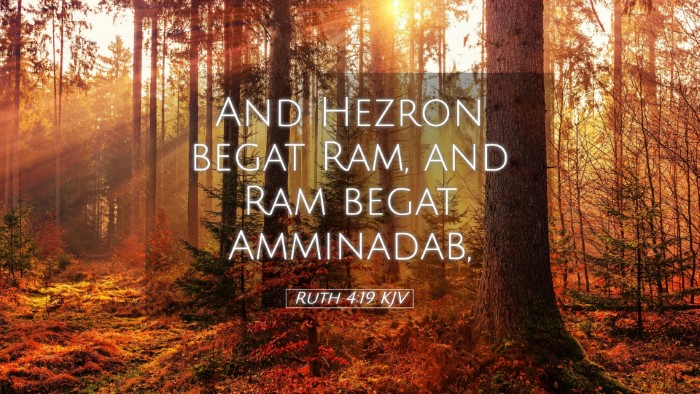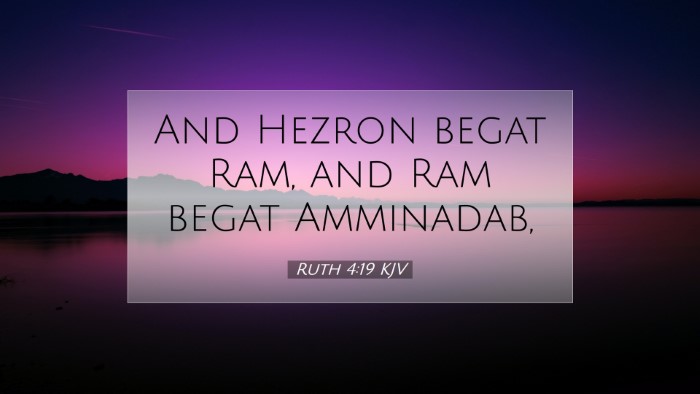Old Testament
Genesis Exodus Leviticus Numbers Deuteronomy Joshua Judges Ruth 1 Samuel 2 Samuel 1 Kings 2 Kings 1 Chronicles 2 Chronicles Ezra Nehemiah Esther Job Psalms Proverbs Ecclesiastes Song of Solomon Isaiah Jeremiah Lamentations Ezekiel Daniel Hosea Joel Amos Obadiah Jonah Micah Nahum Habakkuk Zephaniah Haggai Zechariah MalachiRuth 4:19
Ruth 4:19 KJV
And Hezron begat Ram, and Ram begat Amminadab,
Ruth 4:19 Bible Commentary
Commentary on Ruth 4:19
The verse Ruth 4:19 states: "And Hezron begat Ram, and Ram begat Amminadab," which is a part of the genealogy of David located in the concluding chapter of the Book of Ruth. This genealogy is significant both historically and theologically, as it foreshadows the lineage of Jesus Christ as described in the New Testament.
Contextual Background
The Book of Ruth is set during a time of the Judges in Israel, a period marked by social and spiritual decline. Ruth, a Moabitess, demonstrates remarkable faithfulness and loyalty first to her mother-in-law Naomi and subsequently to God’s covenant people. Ruth’s story illustrates God’s providential care in the lives of those who seek Him, as well as His inclusivity toward Gentiles who come to faith.
Insights from Commentaries
Genealogy and Its Importance
The genealogy in Ruth 4:19, with Hezron as the patriarchal figure leading to King David, mirrors similar genealogical lists found in the Gospels (Matthew 1:3-16; Luke 3:23-38). Such lists serve multiple purposes:
- Historical Validation: The genealogical record anchors the narrative of Ruth in a historical context, demonstrating the reality and continuation of David's lineage.
- Theological Significance: The inclusion of Ruth, a Moabite woman, emphasizes God’s redemptive plan encompassing all people, foreshadowing the grafting of Gentiles into the family of God.
- Fulfillment of Promises: This genealogy underlines the fulfillment of God's promises to Abraham, Isaac, and Jacob about their descendants becoming a great nation.
Matthew Henry's Insights
Matthew Henry elaborates on the idea that the genealogy, while seemingly dry, is rich in implications for understanding God's grace and providence. The names listed are not merely of historical interest but are a celebration of God’s faithfulness across generations. He notes that Hezron’s lineage eventually leads to David, thus showcasing that Ruth's faith and loyalty contribute to the covenant relationship initiated with Israel.
Albert Barnes' Commentary
Albert Barnes focuses on the importance of each name in the lineage. He suggests that every name represents a story of God's faithfulness and the unfolding of His redemptive purposes. He highlights that Ram, who is mentioned in this verse, is a key figure in the history of Israel, further establishing the legitimacy of David’s claim to the throne. The veracity of these genealogical records gives weight to the historical and prophetic claims made about David's dynasty and, ultimately, the Messiah.
Adam Clarke's Reflections
Adam Clarke provides a reflective insight on the concept of heritage and its implications for both Israelites and Christians today. He connects the significance of Ruth’s inclusion in the genealogy to the Christian belief in the inheritance of the Kingdom of God. Clarke also notes the importance of acknowledging our spiritual heritage, which shapes our identity in Christ. The mention of Hezron and his descendants reminds believers of the continuity of faith from the Old Testament to the New Testament.
Theological Implications
The theological implications of Ruth 4:19 extend beyond mere ancestry. Believers are reminded that God operates through history, weaving together the lives of individuals to fulfill His glorious plan of salvation, demonstrating that His salvation is not confined but extends to all who call upon His name.
Ruth as a Model of Faith
Ruth's narrative serves as a lesson not only in faithfulness but in the inclusivity of God’s grace. Her willingness to leave her homeland and embrace Naomi’s people exemplifies a radical trust in God. This becomes an encouraging message for modern-day believers: that one's past or ethnic background does not preclude access to God’s redemptive work.
Current Applications for Pastors and Theologians
Pastors and theologians can draw several applications from this verse:
- Preaching Grace: The narrative demonstrates God's redemptive grace that transcends boundaries and expectations.
- Encouraging Faithfulness: Ruth’s dedication serves as a model for congregants on loyalty and faith amidst adversity.
- Understanding Heritage: Church leaders can emphasize the significance of spiritual heritage, fostering a deeper appreciation for the faithfulness of those who came before us.
- Promoting Inclusivity: Ruth’s inclusion in Jesus’ genealogy challenges the church to embrace all people, affirming that faith in Christ is the unifying factor for all believers.
Conclusion
Ruth 4:19 encapsulates a powerful moment of transition in the Old Testament narrative, connecting the dots from Ruth's faithfulness to the lineage of David and ultimately to Jesus Christ. The insights drawn from historical context, genealogical significance, and theological implications converge to reveal a God who is intricately involved in the affairs of humanity. This understanding enriches the pastoral message and offers profound truth for scholars, students, and believers alike as they explore the depth of God's loving plan through His Word.


